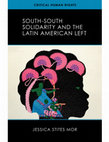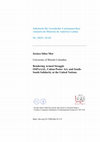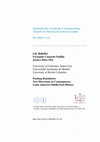Books by Jessica Stites Mor

The Art of Solidarity: Visual and Performative Politics in Cold War Latin America, 2018
The Cold War claimed many lives and inflicted tremendous psychological pain throughout the Americ... more The Cold War claimed many lives and inflicted tremendous psychological pain throughout the Americas. The extreme polarization that resulted from pitting capitalism against communism held most of the creative and productive energy of the twentieth century captive. Many artists responded to Cold War struggles by engaging in activist art practice, using creative expression to mobilize social change. The Art of Solidarity examines how these creative practices in the arts and culture contributed to transnational solidarity campaigns that connected people across the Americas from the early twentieth century through the Cold War and its immediate aftermath.
This collection of original essays is divided into four chronological sections: cultural and artistic production in the pre–Cold War era that set the stage for transnational solidarity organizing; early artistic responses to the rise of Cold War polarization and state repression; the centrality of cultural and artistic production in social movements of solidarity; and solidarity activism beyond movements. Essay topics range widely across regions and social groups, from the work of lesbian activists in Mexico City in the late 1970s and 1980s, to the exchanges and transmissions of folk-music practices from Cuba to the United States, to the uses of Chilean arpilleras to oppose and protest the military dictatorship. While previous studies have focused on politically engaged artists or examined how artist communities have created solidarity movements, this book is one of the first to merge both perspectives.
Introduction: Transnational Pathways of Empathy in the Americas (Jessica Stites Mor and Maria del Carmen Suescun Pozas)
Part I. Preparing the Ground, Holding Ground, 1944–2015
Chapter 1. “My Art Speaks for Both My Peoples”: Elizabeth Catlett in Mexico (Melanie Anne Herzog)
Chapter 2. Traditions of Resistance, Expressions of Solidarity, and the Honduran Coup (Katherine Borland)
Part II. Resistance and Liberation, 1960–1974
Chapter 3. Ignácio de Loyola Brandão’s Zero and the Aesthetics of Resistance in 1960s Brazil (Javier González)
Chapter 4. Canto Libre: Folk Music and Solidarity in the Americas, 1967–1974 (Ashley Black)
Part III. Cultural Economies of Solidarity, 1970–1987
Chapter 5. “¡Estamos Hartas!”: Feminist Performances, Photography, and the Meanings of Political Solidarity in 1970s Mexico (Gabriela Aceves Sepúlveda)
Chapter 6. “Amor Solidario”: Revolutionary Lesbianism in Mexico City, 1977–1987 (Lucinda Grinnell)
Part IV. Solidarity Action beyond Movements
Chapter 7. Solidarity in Spectatorship (Kevin Coleman)
Chapter 8. What Is Solidarity Art? (Jacqueline Adams)
Epilogue (Ernesto Capello)
Acknowledgments
Bibliography
Contributors
Index

South-South Solidarity and the Latin American Left, 2022
Transnational solidarity movements often play an important role in reshaping structures of global... more Transnational solidarity movements often play an important role in reshaping structures of global power. However, there remains a significant gap in the historical literature on collaboration between parties located in the Global South. Facing increasing repression, the Latin American left in the 1960s and 1970s found connection in transnational exchange, organizing with distant activists in Africa, the Middle East, and the Caribbean. By exploring the particularities of South-South solidarity, this volume begins new conversations about what makes these movements unique, how they shaped political identities, and their lasting influence. Jessica Stites Mor looks at four in-depth case studies: the use of legal reform to accomplish the goals of solidarity embedded in Mexico’s revolutionary constitution, visual and print media circulated by Cuba and its influence on the agenda of the Afro-Asian block at the United Nations, organizing on behalf of Palestinian nationalism in reshaping Argentina’s socialist left, and the role of Latin American Catholic activists in challenging the South African apartheid state. These examples serve as a much-needed road map to navigate our current political climate and show us how solidarity movements might approach future struggles.

In May of 1976, documentary filmmaker and proclaimed socialist Raymundo Gleyzer mysteriously disa... more In May of 1976, documentary filmmaker and proclaimed socialist Raymundo Gleyzer mysteriously disappeared in Buenos Aires. Like many political activists, Gleyzer was the target of a brutalizing military junta that had recently assumed power. Amazingly, within a few decades, leftist filmmakers would be celebrated as intellectual vanguards in this same city.
In Transition Cinema, Jessica Stites Mor documents the critical role filmmakers, the film industry, and state regulators played in ArgentinaÆs volatile transition to democracy. She shows how, during different regimes, the state moved to either inhibit or facilitate film production and its content, distribution, and exhibition. She also reveals the strategies the film industry employed to comply with, or circumvent these regulations.
Stites Mor divides the transition period into three distinct generations, each defined by a major political event and the reactions to these events in film. The first generation began with the failed civil uprising in Córdoba in 1969, and ended with the 1976 military takeover. During military rule, repressive censorship spurred underground exhibitions, and allied filmmakers with the Peronist left and radical activists. The second generation arose after the return of civilian rule in 1983. Buenos Aires became the center for state-level cultural programs that included filmmakers in debates over human rights and collective memory campaigns. In 1989, a third generation of filmmaking emerged, with new genres such as cine piquetero (picketer cinema) that portrayed a variety of social movements and brought them into the public eye. By the new millennium, Argentine filmmakers had gained the attention and financial support of international humanitarian and film industry organizations.
In this captivating study, Stites Mor examines how populist movements, political actors, filmmakers, government, and industry institutions all became deeply enmeshed in the project of ArgentinaÆs transition cinema. She demonstrates how film emerged as the chronicler of political struggles in a dialogue with the past, present, and future, whose message transcended both cultural and national borders.

With the end of the global Cold War, the struggle for human rights has emerged as one of the most... more With the end of the global Cold War, the struggle for human rights has emerged as one of the most controversial forces of change in Latin America. Many observers seek the foundations of that movement in notions of rights and models of democratic institutions that originated in the global North. Challenging that view, this volume argues that Latin American community organizers, intellectuals, novelists, priests, students, artists, urban pobladores, refugees, migrants, and common people have contributed significantly to new visions of political community and participatory democracy. These local actors built an alternative transnational solidarity from below with significant participation of the socially excluded and activists in the Global South.
Edited by Jessica Stites Mor, this book offers fine-grained case studies that show how Latin America’s re-emerging Left transformed the struggles against dictatorship and repression of the Cold War into the language of anti-colonialism, socioeconomic rights, and identity.
Articles and Chapters by Jessica Stites Mor

The two decades between 1955 and 1976, bookended by the beginning of a military coup that ousted ... more The two decades between 1955 and 1976, bookended by the beginning of a military coup that ousted populist President Juan Peron in 1955 and the dictatorship that replaced a democratically elected government in 1976, was a period of tremendous political radicalism that would leave a permanent impression on Argentina’s political history. During this period, left wing parties in Argentina, already “extensive, prolific, [with] countless complexities and contradictions,” 2 gradually transformed from traditional orthodox parties of the left and the labor movement into a ‘new left,’ introducing a wide range of ideological influences. The nueva izquierda drew from crowds of intellectuals, university students, defectors from traditional parties, guerrillas, and social movements, raising a challenge to the legitimacy of traditional leftist parties in representing the spectrum of political concerns and ambitions of the left.

Documentary and political filmmaking has been lauded by historians as the revisionist's playgroun... more Documentary and political filmmaking has been lauded by historians as the revisionist's playground, the repository of personal testimonies about the past, and the scene of collective memory struggles and shared fantasies of the past. For the military dictatorships that came to power with U.S. support during the Cold War in Latin America, particularly those in Chile, Brazil, and Argentina, the suppression of outspoken cultural critics was seen as an important feature of maintaining the illusion of public support. In Argentina, politicized filmmakers were frequently victims of state violence, and military regimes, of which there were several in the 1960s to the early 1980s, targeted prominent directors, writers, and actors, forcing many into hiding in order to suppress their critical viewpoints. However, as Argentine filmmakers sought refuge in exile in cities like Havana, Paris, Prague, and Mexico, they were welcomed into political and creative communities invested in internationalism, non-alignment, and other forms of transnational resistance to the dictates of the Cold War. The adaptability of film to the service of such campaigns was not lost on Argentine exiles, and within these sites of contest, many renewed their filmmaking activity in order to create a means by which they could raise awareness about human rights abuses and dictatorship at home. Argentine directors found themselves at the forefront of the articulation of a new form of activist filmmaking, Third World Cinema, which provided a model for crafting solidarity networks through rebellious film spaces and the use of film as a vehicle for presenting counternarratives to the Argentine state. As the Cold War continued, these transnational solidarity networks, organized on behalf of Argentine causes, brought pressure on the dictatorship to end censorship and restore democratic institutions, revealing transnational solidarity film networks to be a powerful political resource and force of change. Political and documentary films became a vital means to understanding Argentina's state repression abroad. And once democracy was restored, these same films were essential tools of rebuilding the left in the aftermath of repression. However, this model of solidarity had its limits. To fully understand the way in which this mode of transnational solidarity operated

Journal of Iberian and Latin American Research, 2014
Political identification with Palestinian nationalism in Argentina has been used by a variety of ... more Political identification with Palestinian nationalism in Argentina has been used by a variety of parties on the left as a symbolic and transgressive tool to shape and re-situate ideological positions. The 'Question of Palestine' and the relationship of the Palestinian diaspora to the Israeli state can be read through the political literature of the left as a mirror of its own shifting engagement with imperialism, the Cold War, neo-liberalism, and social exclusion. This article explores the Argentine left's exchange with and mediated understandings of the Palestinian Liberation Organization, the Arab League, the Organization of Arab States, and Zionism, in order to reveal the motivations behind pro-Palestine transnational solidarity campaigns. It argues for the strategic relevance of South-South transnational solidarity mobilization to the emergence of Argentina's 'new left.'

Jahrbuch für Geschichte Lateinamerikas - Anuario de Historia de América Latina, 2019
This article considers the role of the Organization of Solidarity with the Peoples of Africa, Asi... more This article considers the role of the Organization of Solidarity with the Peoples of Africa, Asia, and Latin America (OSPAAAL) in championing a Latin American, tricontinentalist vision of Third World solidarity between these regions. It argues that Cuba used visual and media arts to frame and reframe historical evets, utilizing OSPAAAL as a conduit of pro-Cuba revolutionary ideas, as it circulated updates on national liberation struggles and calls to action for internationalist solidarity. OSPAAAL produced visual art in solidarity campaigns that allowed Cuba to promote a particular interpretation of the Cold War as ongoing colonialism to generate transnational support for national liberation struggles in the Middle East and Africa, as well as to promote the Cuban revolution itself. In particular, it examines the way that the visual approach used by the artists working with OSPAAAL intersected with other modes of transnational solidarity activism to promote revolutionary ideals and commonalities between distant participants and specifically in order to influence international cooperation at the United Nations and in advancing Castro's profile within the Non-Aligned Movement.

The two decades between 1955 and 1976, bookended by the beginning of a military coup that ousted ... more The two decades between 1955 and 1976, bookended by the beginning of a military coup that ousted populist President Juan Perón in 1955 and the dictatorship that replaced a democratically elected government in 1976, was a period of tremendous political radicalism that would leave a permanent impression on Argentina's political history. During this period, left wing parties in Argentina, already "extensive, prolific, [with] countless complexities and contradictions," 2 gradually transformed from traditional orthodox parties of the left and the labor movement into a 'new left,' introducing a wide range of ideological influences. The nueva izquierda drew from crowds of intellectuals, university students, defectors from traditional parties, guerrillas, and social movements, raising a challenge to the legitimacy of traditional leftist parties in representing the spectrum of political concerns and ambitions of the left.
El cine argentino de hoy, Jan 1, 2008
Transgresión y responsabilidad: desplazamiento de los discursos feministas en cineastas argentina... more Transgresión y responsabilidad: desplazamiento de los discursos feministas en cineastas argentinas desde María Luisa Bemberg hasta Lucrecia Martel* Jessica Stites Mor En los últimos diez años, muchas mujeres cineastas han empezado a autoi-dentificarse como ...
Special issues by Jessica Stites Mor

Journal of Iberian and Latin American Research, 2014
Manifestations of trans-border solidarity between geographically distant, different or unequal gr... more Manifestations of trans-border solidarity between geographically distant, different or unequal groups and communities are phenomena accompanying the evolution of a transnational Left during the 20 th century. They attended struggles for civil and human rights, social movements and challenges to Cold War neo-imperialism. Transnational solidarity movements offered powerful political resources for accessing public opinion in order to mobilize for programs of social and political change. This dossier offers a set of case studies that demand theoretical re-considerations of earlier scholarly framings of solidarity to address a Latin American perspective. It seeks to explore the motivations and practices of phenomena of transnational solidarity throughout the 20 th century, focusing on the distinct dynamics that emerged in the global South. The aim is to re-centre transnational solidarity analysis from the vantage point of the often neglected South-North as well South-South directions of solidarity activism, as well as to resituate the social and cultural exchanges of local agents.
Canadian Journal of Latin American and Caribbean Studies / Revue canadienne des études latino-américaines et caraïbes

This dossier considers two central concerns surrounding the reconfiguration of formerly militant ... more This dossier considers two central concerns surrounding the reconfiguration of formerly militant activism in recent Latin American history. It considers the political transformation of former militants and the networks and routes used by former militant actors to transform themselves, via the notion of reconversion, and their relationship to shifting landscapes of access to the state. It also uses case studies to reflect on the reconfiguration of militancy in societies that have undergone substantial neoliberal reforms. As individual activists move between volunteer activity or voluntary political association—such as activism in political parties, local community associations, various types of social movements, and organizations—to professional political activity, this dossier argues that they inherently must move through a process of adaptation. Empirical analysis of these conversions captures more nuanced and profound changes regarding the place of activism in Latin American societies in recent decades, the opening of new spaces for the “left” and emerging social movements, and the partisan reorganization of actors from various political and social groups.

This dossier addresses some of the lesser-explored historical legacies of the Cold War by d... more This dossier addresses some of the lesser-explored historical legacies of the Cold War by delving into the newly emerging landscape of Middle East-Latin American relations of this period. Informing this investigation of geopolitical power and concomitant South-South dialogues that coalesced as part of that Cold War reality, the dossier brings together work that not only transgresses the typical boundaries between area studies of these regions but also pushes for a departure from the way in which Middle East-Latin American relations have often been relegated to and siloed within specific subfields of historical consideration, such as the study of the migration of Arabic-speaking peoples or the field of international relations. The dossier takes advantage of the ability to present several distinctive case studies in order to raise a challenge to historians of this period to broaden their contextualization of the relations between the two regions and to reposition Middle East-Latin American ties within a more complex historical framework of interaction and exchange.










Uploads
Books by Jessica Stites Mor
This collection of original essays is divided into four chronological sections: cultural and artistic production in the pre–Cold War era that set the stage for transnational solidarity organizing; early artistic responses to the rise of Cold War polarization and state repression; the centrality of cultural and artistic production in social movements of solidarity; and solidarity activism beyond movements. Essay topics range widely across regions and social groups, from the work of lesbian activists in Mexico City in the late 1970s and 1980s, to the exchanges and transmissions of folk-music practices from Cuba to the United States, to the uses of Chilean arpilleras to oppose and protest the military dictatorship. While previous studies have focused on politically engaged artists or examined how artist communities have created solidarity movements, this book is one of the first to merge both perspectives.
Introduction: Transnational Pathways of Empathy in the Americas (Jessica Stites Mor and Maria del Carmen Suescun Pozas)
Part I. Preparing the Ground, Holding Ground, 1944–2015
Chapter 1. “My Art Speaks for Both My Peoples”: Elizabeth Catlett in Mexico (Melanie Anne Herzog)
Chapter 2. Traditions of Resistance, Expressions of Solidarity, and the Honduran Coup (Katherine Borland)
Part II. Resistance and Liberation, 1960–1974
Chapter 3. Ignácio de Loyola Brandão’s Zero and the Aesthetics of Resistance in 1960s Brazil (Javier González)
Chapter 4. Canto Libre: Folk Music and Solidarity in the Americas, 1967–1974 (Ashley Black)
Part III. Cultural Economies of Solidarity, 1970–1987
Chapter 5. “¡Estamos Hartas!”: Feminist Performances, Photography, and the Meanings of Political Solidarity in 1970s Mexico (Gabriela Aceves Sepúlveda)
Chapter 6. “Amor Solidario”: Revolutionary Lesbianism in Mexico City, 1977–1987 (Lucinda Grinnell)
Part IV. Solidarity Action beyond Movements
Chapter 7. Solidarity in Spectatorship (Kevin Coleman)
Chapter 8. What Is Solidarity Art? (Jacqueline Adams)
Epilogue (Ernesto Capello)
Acknowledgments
Bibliography
Contributors
Index
In Transition Cinema, Jessica Stites Mor documents the critical role filmmakers, the film industry, and state regulators played in ArgentinaÆs volatile transition to democracy. She shows how, during different regimes, the state moved to either inhibit or facilitate film production and its content, distribution, and exhibition. She also reveals the strategies the film industry employed to comply with, or circumvent these regulations.
Stites Mor divides the transition period into three distinct generations, each defined by a major political event and the reactions to these events in film. The first generation began with the failed civil uprising in Córdoba in 1969, and ended with the 1976 military takeover. During military rule, repressive censorship spurred underground exhibitions, and allied filmmakers with the Peronist left and radical activists. The second generation arose after the return of civilian rule in 1983. Buenos Aires became the center for state-level cultural programs that included filmmakers in debates over human rights and collective memory campaigns. In 1989, a third generation of filmmaking emerged, with new genres such as cine piquetero (picketer cinema) that portrayed a variety of social movements and brought them into the public eye. By the new millennium, Argentine filmmakers had gained the attention and financial support of international humanitarian and film industry organizations.
In this captivating study, Stites Mor examines how populist movements, political actors, filmmakers, government, and industry institutions all became deeply enmeshed in the project of ArgentinaÆs transition cinema. She demonstrates how film emerged as the chronicler of political struggles in a dialogue with the past, present, and future, whose message transcended both cultural and national borders.
Edited by Jessica Stites Mor, this book offers fine-grained case studies that show how Latin America’s re-emerging Left transformed the struggles against dictatorship and repression of the Cold War into the language of anti-colonialism, socioeconomic rights, and identity.
Articles and Chapters by Jessica Stites Mor
Special issues by Jessica Stites Mor
This collection of original essays is divided into four chronological sections: cultural and artistic production in the pre–Cold War era that set the stage for transnational solidarity organizing; early artistic responses to the rise of Cold War polarization and state repression; the centrality of cultural and artistic production in social movements of solidarity; and solidarity activism beyond movements. Essay topics range widely across regions and social groups, from the work of lesbian activists in Mexico City in the late 1970s and 1980s, to the exchanges and transmissions of folk-music practices from Cuba to the United States, to the uses of Chilean arpilleras to oppose and protest the military dictatorship. While previous studies have focused on politically engaged artists or examined how artist communities have created solidarity movements, this book is one of the first to merge both perspectives.
Introduction: Transnational Pathways of Empathy in the Americas (Jessica Stites Mor and Maria del Carmen Suescun Pozas)
Part I. Preparing the Ground, Holding Ground, 1944–2015
Chapter 1. “My Art Speaks for Both My Peoples”: Elizabeth Catlett in Mexico (Melanie Anne Herzog)
Chapter 2. Traditions of Resistance, Expressions of Solidarity, and the Honduran Coup (Katherine Borland)
Part II. Resistance and Liberation, 1960–1974
Chapter 3. Ignácio de Loyola Brandão’s Zero and the Aesthetics of Resistance in 1960s Brazil (Javier González)
Chapter 4. Canto Libre: Folk Music and Solidarity in the Americas, 1967–1974 (Ashley Black)
Part III. Cultural Economies of Solidarity, 1970–1987
Chapter 5. “¡Estamos Hartas!”: Feminist Performances, Photography, and the Meanings of Political Solidarity in 1970s Mexico (Gabriela Aceves Sepúlveda)
Chapter 6. “Amor Solidario”: Revolutionary Lesbianism in Mexico City, 1977–1987 (Lucinda Grinnell)
Part IV. Solidarity Action beyond Movements
Chapter 7. Solidarity in Spectatorship (Kevin Coleman)
Chapter 8. What Is Solidarity Art? (Jacqueline Adams)
Epilogue (Ernesto Capello)
Acknowledgments
Bibliography
Contributors
Index
In Transition Cinema, Jessica Stites Mor documents the critical role filmmakers, the film industry, and state regulators played in ArgentinaÆs volatile transition to democracy. She shows how, during different regimes, the state moved to either inhibit or facilitate film production and its content, distribution, and exhibition. She also reveals the strategies the film industry employed to comply with, or circumvent these regulations.
Stites Mor divides the transition period into three distinct generations, each defined by a major political event and the reactions to these events in film. The first generation began with the failed civil uprising in Córdoba in 1969, and ended with the 1976 military takeover. During military rule, repressive censorship spurred underground exhibitions, and allied filmmakers with the Peronist left and radical activists. The second generation arose after the return of civilian rule in 1983. Buenos Aires became the center for state-level cultural programs that included filmmakers in debates over human rights and collective memory campaigns. In 1989, a third generation of filmmaking emerged, with new genres such as cine piquetero (picketer cinema) that portrayed a variety of social movements and brought them into the public eye. By the new millennium, Argentine filmmakers had gained the attention and financial support of international humanitarian and film industry organizations.
In this captivating study, Stites Mor examines how populist movements, political actors, filmmakers, government, and industry institutions all became deeply enmeshed in the project of ArgentinaÆs transition cinema. She demonstrates how film emerged as the chronicler of political struggles in a dialogue with the past, present, and future, whose message transcended both cultural and national borders.
Edited by Jessica Stites Mor, this book offers fine-grained case studies that show how Latin America’s re-emerging Left transformed the struggles against dictatorship and repression of the Cold War into the language of anti-colonialism, socioeconomic rights, and identity.
Bringing together scholars with versatile linguistic and interdisciplinary skills, Palestine in the World puts the Palestinian movement into conversation with the models of transnational politics that emerged through the revolutionary period. From participation in a vibrant sphere of intellectual and cultural production, the work of travelling revolutionaries as delegates, volunteers, and militants, and the connected mobilisations that took place in different corners of the world, international solidarity with and from the Palestinian movement was integral to its ascendance on the global stage. By treating the Palestinian revolution as a world phenomenon - with cases from Cuba, France, the US, the GDR, Japan and more - this volume reveals the forms of solidarity that shaped the rise of the movement and their afterlives today. It illuminates the rich connected histories of international solidarity that positioned the Palestinian movement as an iconic anticolonial struggle.